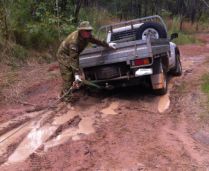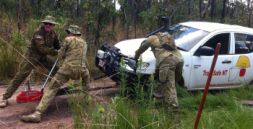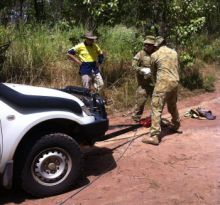
The Army uses Train Safe NT
Training the Australian Army
I was lucky to be involved in training soldiers (Department of Defence) in 4WD vehicle recovery. The course was a unit of competency so it was Nationally Recognised Training this met the standards for Army personnel. The day started with a check of all recovery equipment and a pre-run to make sure it all worked and fitted together. Checking equipment prior to getting a vehicle bogged is very important as you can imagine once the car is bogged its pretty serious so we have to make sure all recovery and safety equipment is safe and can do the job.
It is very important to check the gross vehicle mass (GVM) this can be found on the compliance plate usually near the driver’s door on new vehicles. The GVM is the weight of the bogged car so if it’s a Toyota Landcruiser and has a GVM of 3.8 ton then the shackles should be rated for 4.7 ton and the tree saver must have a rating of 8 ton. The recovery equipment must be greater than the weight of the bogged vehicle.

As you can see in this photo the vehicles left wheels are wedged in a deep rut so it took a lot of energy to remove the car. The tree saver was wrapped around the hitch bar and rated for 8 ton, then a 4.7 ton shackle is used to attach the cable. 4WD recovery courses in Darwin

It was pretty tough going, the day was very hot and humid and we were working in full sun for about 4 hours. The blokes were hard workers but removing a vehicle by hand is hard yakka, the students were trained in the use of a hand winch or “turfer”, this was attached to the recovery points of the vehicle, each recovery point has a rating of 2.5 ton so a total of 5 ton. The hand winch has the ability to remove these vehicles from the mud.
Working with the Army was a great experience, each student could offer knowledge and experience so all participants were able to learn from each other. As a trainer, I was able to test my skills and to be able to teach to the standards that the defence personnel require was a good achievement.
During the course, we covered five (5) methods of recovery, Workhealth Safety (WHS) was a big component of the course, everything we did was focused on the safest way not the fastest. At the end of the course all people were happy with the training so we look forward to doing more courses in the future. James Gorrie has been training for over fifteen (15) years in the NT.
